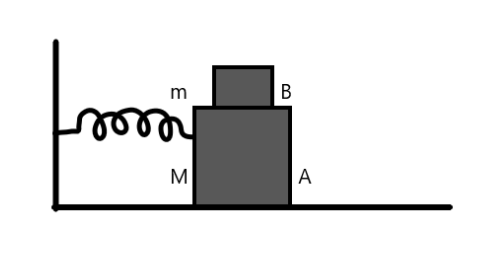Answer
64.8k+ views
Hint: For smaller blocks not to fall off, the maximum force on the lower block must be equal to the frictional force between the small block and large block. The force acting on the lower block is provided by the spring attached to it.
Formula used: In this solution we will be using the following formulae;
\[F = ke\] where \[F\] is the elastic force exerted by a string, \[k\] is the string constant and \[e\] is the extension of the string from equilibrium.
\[f = \mu mg\] where \[f\] is the frictional force acting on a surface, \[\mu \] is the coefficient of friction between the surface of the two bodies.
Complete Step-by-Step solution:
As it is seen, if the lower block is displaced, the spring will exert a restoring force proportional to the extension of the string.
For the block on top not to fall, the maximum force exerted would need to be equal to the maximum static friction between the surfaces of the two blocks.
The force due to a string is given by
\[F = ke\] where \[k\] is the string constant and \[e\] is the extension of the string from equilibrium.
While the frictional force can be given as
\[f = \mu mg\] where \[\mu \] is the coefficient of friction between the surface of the two bodies.
Hence, equating the two, we have that
\[ke = \mu mg\]
Maximum force occurs at amplitude, hence
\[kA = \mu mg\]
\[ \Rightarrow A = \dfrac{{\mu mg}}{k}\]
Hence, the correct option is
Note: For clarity, the reason why the maximum force applied to the lower block must be equal to the surface is due to Newton’s law. When a force is applied to the bottom, the top block, on its own reference frame can be likened to the same amount of force pushing it away from t
the bottom block. If it were moving at a constant velocity, the top block would not fall off, ever.
Formula used: In this solution we will be using the following formulae;
\[F = ke\] where \[F\] is the elastic force exerted by a string, \[k\] is the string constant and \[e\] is the extension of the string from equilibrium.
\[f = \mu mg\] where \[f\] is the frictional force acting on a surface, \[\mu \] is the coefficient of friction between the surface of the two bodies.
Complete Step-by-Step solution:
As it is seen, if the lower block is displaced, the spring will exert a restoring force proportional to the extension of the string.
For the block on top not to fall, the maximum force exerted would need to be equal to the maximum static friction between the surfaces of the two blocks.
The force due to a string is given by
\[F = ke\] where \[k\] is the string constant and \[e\] is the extension of the string from equilibrium.
While the frictional force can be given as
\[f = \mu mg\] where \[\mu \] is the coefficient of friction between the surface of the two bodies.
Hence, equating the two, we have that
\[ke = \mu mg\]
Maximum force occurs at amplitude, hence
\[kA = \mu mg\]
\[ \Rightarrow A = \dfrac{{\mu mg}}{k}\]
Hence, the correct option is
Note: For clarity, the reason why the maximum force applied to the lower block must be equal to the surface is due to Newton’s law. When a force is applied to the bottom, the top block, on its own reference frame can be likened to the same amount of force pushing it away from t
the bottom block. If it were moving at a constant velocity, the top block would not fall off, ever.
Recently Updated Pages
Write a composition in approximately 450 500 words class 10 english JEE_Main

Arrange the sentences P Q R between S1 and S5 such class 10 english JEE_Main

What is the common property of the oxides CONO and class 10 chemistry JEE_Main

What happens when dilute hydrochloric acid is added class 10 chemistry JEE_Main

If four points A63B 35C4 2 and Dx3x are given in such class 10 maths JEE_Main

The area of square inscribed in a circle of diameter class 10 maths JEE_Main




